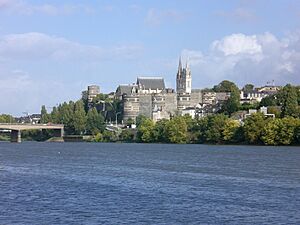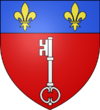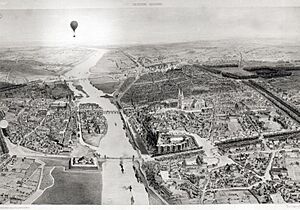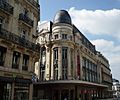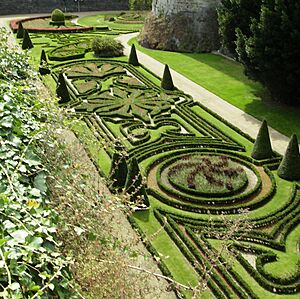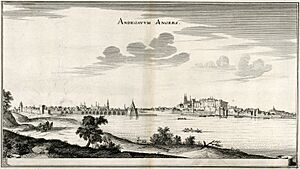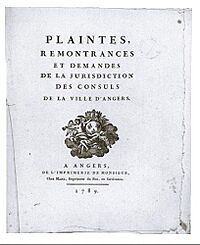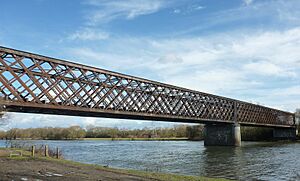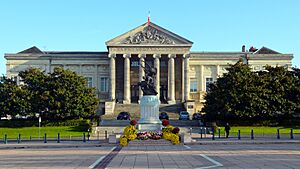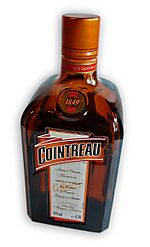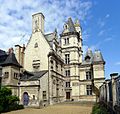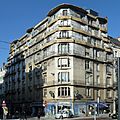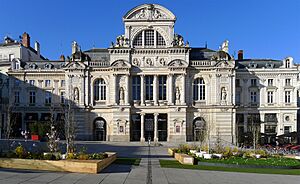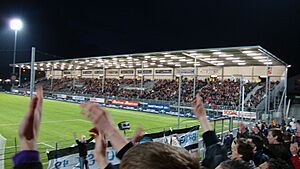Angers facts for kids
Quick facts for kids
Angers
|
|||
|---|---|---|---|
|
Prefecture and commune
|
|||
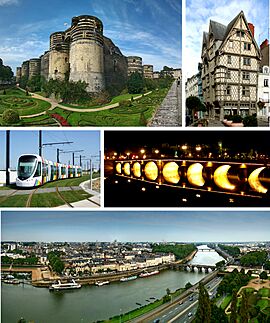
Top to bottom, left to right: Château d'Angers, Maison d'Adam; Angers tram, Verdun Bridge at night; view of the river Maine, Verdun Bridge and downtown area from Angers Castle
|
|||
|
|||
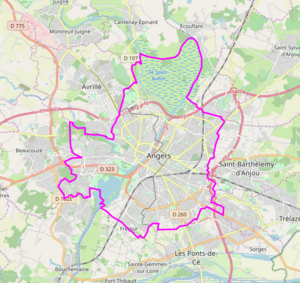 |
|||
| Country | France | ||
| Region | Pays de la Loire | ||
| Department | Maine-et-Loire | ||
| Arrondissement | Angers | ||
| Canton | Angers-1, 2, 3, 4, 5, 6, 7 | ||
| Intercommunality | CU Angers Loire Métropole | ||
| Area
1
|
42.70 km2 (16.49 sq mi) | ||
| • Urban | 243.3 km2 (93.9 sq mi) | ||
| • Metro | 2,418.7 km2 (933.9 sq mi) | ||
| Population
(2021)
|
157,175 | ||
| • Rank | 18th in France | ||
| • Density | 3,680.9/km2 (9,533.5/sq mi) | ||
| • Urban
(2018)
|
242,613 | ||
| • Urban density | 997.18/km2 (2,582.7/sq mi) | ||
| • Metro
(2018)
|
432,939 | ||
| • Metro density | 178.997/km2 (463.599/sq mi) | ||
| Demonym(s) | Angevin (masculine) Angevine (feminine) |
||
| Time zone | UTC+01:00 (CET) | ||
| • Summer (DST) | UTC+02:00 (CEST) | ||
| INSEE/Postal code |
49007 /49000, 49100
|
||
| Elevation | 12–64 m (39–210 ft) | ||
| 1 French Land Register data, which excludes lakes, ponds, glaciers > 1 km2 (0.386 sq mi or 247 acres) and river estuaries. | |||
Angers is a city in western France. It is about 300 kilometers (186 miles) southwest of Paris. Angers is the main city of the Maine-et-Loire area. It used to be the capital of the Anjou region until the French Revolution. People from Angers are called Angevins.
The city of Angers itself covers 42.70 square kilometers (16.49 sq mi). About 154,508 people live there. If you include the surrounding areas, the population is around 432,900. Angers is the third largest city in northwestern France, after Nantes and Rennes. It is the 18th most populated city in all of France.
For many centuries, Angers was a very important stronghold in northwestern France. It was the birthplace of the Plantagenet royal family. It also became a major center for learning when René of Anjou was in charge. Angers grew where three rivers meet: the Mayenne, the Sarthe, and the Loir. These rivers flow from the north into the Loire river. Just north of Angers, they join to form the Maine river. The Maine is short but wide and flows into the Loire a few kilometers south.
Today, Angers is known for its plant industry. Végépolys is Europe's top center for gardening and plant research. The city also has the main office for new plant varieties in Europe. The Angers area is a big economic hub in western France. It is active in industry and tourism. Angers has a rich cultural life, thanks to its universities and museums. The old medieval center still has the huge castle of the Plantagenêt family. This castle is home to the Apocalypse Tapestry. This is the biggest medieval tapestry in the world. Angers is also near the Val de Loire, a World Heritage Site. It is also close to the Loire-Anjou-Touraine natural park.
Contents
- Discovering Angers' Name and Symbols
- Exploring Angers' Location and Surroundings
- A Look at Angers' Past
- How Angers is Managed
- Angers' Population and People
- Angers' Economy and Jobs
- Getting Around Angers
- Angers' Culture and Fun
- Sports in Angers
- Famous People from Angers
- Angers' Sister Cities
- Images for kids
- See also
Discovering Angers' Name and Symbols
How Angers Got Its Name
The city was first mentioned around 150 AD by Ptolemy. He called it Juliomagus. This name means "Julius's market." It likely referred to Julius Caesar. Later, it was called Juliomagus Andecavorum. This meant "Juliomagus of the Andecavi", which was the local Celtic tribe.
Around 400 AD, people started calling it the civitas Andecavorum. This means "tribal capital of the Andecavi." Over time, this name changed to the modern "Angers." It was called Andecava civitas in the 6th century. Then it became Andecavis (769 AD), Andegavis (861-882), Angieus (1127), and Angeus (1205). The name Angiers appeared in the 12th century and later became "Angers." The Latin name Andecavum also gave the Anjou region its name.
Angers' Fun Nicknames
Angers was often called the "Black City" (la Ville Noire). This was because many roofs were made of slate from nearby quarries. Today, this is less common.
The city also has other names:
- "The Athens of the West" (Athènes de l'Ouest). This name came from its growing university in the 1800s.
- "The City of Flowers" (Ville des fleurs). This name started in the mid-1800s.
- "Green City" (Ville verte). This refers to its many parks and plant industry.
- "Angers the White" (Angers la Blanche). This name comes from its modern white stone buildings.
Angers' Coat of Arms
The coat of arms of Angers shows the French royal fleur de lys. These were used by the dukes of Anjou. The key on the shield shows that Angers was a strong city near the Breton border. An old poem called it "Ancient key to France."
Under Napoleon I's rule, Angers was a special city. It was allowed to have a new coat of arms. Bees, a symbol of Napoleon's empire, replaced the fleurs de lys.
In 1949, Angers received a special award for its role in World War II. This award is sometimes shown on the coat of arms.
Exploring Angers' Location and Surroundings
Where is Angers Located?

Angers is in the middle of the Maine-et-Loire area. It is on the main road that links Paris to the Atlantic Ocean. The city sits just south of where the Loir, Mayenne, and Sarthe rivers meet. These rivers form the Maine river. The Maine flows through Angers and then into the Loire river. This natural meeting point of rivers helped the ancient city of Juliomagus to be founded here.
Angers is 91 km (57 mi) from Nantes and 297 km (185 mi) from Paris. The closest beach is 118 km (73 mi) away on the Atlantic Ocean. The city's elevation ranges from 12 to 64 meters (39 to 210 ft) above sea level.
Angers is a hilly city. A rocky hill overlooks the Maine river valley. This hill was where the old city was built. It still holds the city's castle, cathedral, and medieval parts.
North and south of Angers, where the Maine river enters and leaves, there are islands and wetlands. These areas are home to many birds and plants typical of the Val de Loire. The étang Saint-Nicolas and Lac de Maine are large green spaces in the city.
Angers' City Layout
The oldest streets and buildings in Angers are on the hill where the Angers castle stands. The city's layout here dates back to the 1200s, 1300s, and 1400s.
A military fort was on this site as early as the 200s. Parts of an old city wall can still be seen at the castle. This wall was built to protect the city from invasions.
During the Middle Ages, the castle was the heart of the city's defenses. It had tall city walls and river chains to stop enemy ships. The walls were rebuilt between 1230 and 1240 by King Louis IX. Today, parts of the wall and some towers are still visible.
Before the 1800s, the city had not grown much beyond its medieval borders. There were some homes on the other side of the Maine river in a neighborhood called La Doutre. This area grew quickly during the Industrial Revolution. It became a large river port. Industries like textile factories and distilleries helped it grow.
After 1850, many new areas appeared around the train stations and slate quarries. The city grew more on the eastern side of the Maine river, where Juliomagus was founded.
The medieval city center was rebuilt and expanded from 1791. The main square, Place du Ralliement, was built where three churches were destroyed. Later, tree-lined boulevards replaced the old city walls. The buildings often had a style similar to those in Paris.
After World War II, many large apartment buildings were built around the city center. Industrial activity changed. Port activity decreased, and new factories were built. In the 1970s, more individual houses were built for families.
As the city grew, people started traveling more for work. New shopping areas were built near the smaller towns that became part of Angers. Because of the floodplains around the city, Angers mainly grows from east to west.
Green Spaces in Angers
Angers has many natural areas. It is on the edge of the Val de Loire World Heritage site. It is also where France's largest rivers meet. Saint-Aubin island, north of the city center, is a protected area of swamps and meadows. It covers one-tenth of the city's total area.
The oldest green areas are from the Renaissance. The castle moats were turned into gardens. Similar gardens were built by rich families. The Jardin des plantes, the first botanical garden, opened in the early 1700s. More parks were built later, like the Jardin du Mail. The étang Saint-Nicolas, a lake, was protected in 1936.
The Lac de Maine, an artificial lake, was created in the 1960s. It is now a marina. In 2010, a large amusement park called Terra Botanica opened near Saint-Aubin island.
Angers' Climate
Angers has an oceanic climate. This means it has moderate rain all year. Winters have few frosts and snowfalls. Summers are warm and sunny.
| Climate data for Angers (located in Beaucouzé, 1991–2020 normals) | |||||||||||||
|---|---|---|---|---|---|---|---|---|---|---|---|---|---|
| Month | Jan | Feb | Mar | Apr | May | Jun | Jul | Aug | Sep | Oct | Nov | Dec | Year |
| Record high °C (°F) | 17.1 (62.8) |
21.2 (70.2) |
24.8 (76.6) |
29.7 (85.5) |
32.8 (91.0) |
40.1 (104.2) |
40.7 (105.3) |
38.7 (101.7) |
35.7 (96.3) |
30.5 (86.9) |
22.2 (72.0) |
19.0 (66.2) |
40.7 (105.3) |
| Mean daily maximum °C (°F) | 8.8 (47.8) |
9.9 (49.8) |
13.3 (55.9) |
16.4 (61.5) |
19.9 (67.8) |
23.5 (74.3) |
25.8 (78.4) |
25.9 (78.6) |
22.4 (72.3) |
17.4 (63.3) |
12.3 (54.1) |
9.2 (48.6) |
17.1 (62.8) |
| Daily mean °C (°F) | 6.0 (42.8) |
6.4 (43.5) |
9.0 (48.2) |
11.3 (52.3) |
14.7 (58.5) |
18.1 (64.6) |
20.0 (68.0) |
20.1 (68.2) |
16.9 (62.4) |
13.4 (56.1) |
9.1 (48.4) |
6.3 (43.3) |
12.6 (54.7) |
| Mean daily minimum °C (°F) | 3.3 (37.9) |
2.9 (37.2) |
4.6 (40.3) |
6.3 (43.3) |
9.6 (49.3) |
12.6 (54.7) |
14.3 (57.7) |
14.3 (57.7) |
11.4 (52.5) |
9.3 (48.7) |
5.9 (42.6) |
3.5 (38.3) |
8.2 (46.8) |
| Record low °C (°F) | −15.4 (4.3) |
−12.8 (9.0) |
−10.6 (12.9) |
−3.4 (25.9) |
−1.6 (29.1) |
2.3 (36.1) |
4.5 (40.1) |
5.1 (41.2) |
2.5 (36.5) |
−3.2 (26.2) |
−8.0 (17.6) |
−13.4 (7.9) |
−15.4 (4.3) |
| Average precipitation mm (inches) | 69.9 (2.75) |
54.4 (2.14) |
52.8 (2.08) |
54.7 (2.15) |
59.4 (2.34) |
48.7 (1.92) |
45.0 (1.77) |
48.2 (1.90) |
56.5 (2.22) |
71.9 (2.83) |
72.9 (2.87) |
74.9 (2.95) |
709.3 (27.93) |
| Average precipitation days | 11.4 | 9.5 | 9.4 | 9.7 | 9.2 | 6.8 | 6.1 | 7.1 | 7.6 | 10.6 | 11.9 | 11.7 | 110.9 |
| Average snowy days | 1.7 | 1.9 | 1.4 | 0.2 | 0.1 | 0.0 | 0.0 | 0.0 | 0.0 | 0.0 | 0.4 | 1.3 | 7.0 |
| Average relative humidity (%) | 88 | 84 | 80 | 77 | 77 | 75 | 74 | 76 | 80 | 86 | 89 | 89 | 81.3 |
| Mean monthly sunshine hours | 68.4 | 97.7 | 142.3 | 179.6 | 205.0 | 224.2 | 235.3 | 225.3 | 191.7 | 120.9 | 84.1 | 70.8 | 1,845.1 |
| Source 1: Meteo France | |||||||||||||
| Source 2: Infoclimat.fr (humidity, snowy days 1961–1990) | |||||||||||||
A Look at Angers' Past
Early Times in Angers

People first lived in Angers around 400,000 BC. Many stone tools from the Neolithic period (New Stone Age) have been found. Burials from 4500-3500 BC were also discovered at the castle.
Around 500 BC, a Celtic tribe called the Andecavi settled north of the Loire river. By the end of the Iron Age, Angers was a busy hillfort. The Romans called it Juliomagus. The Roman town had villas, baths, an amphitheater, and a temple.
In 275 and 276 AD, Germanic invasions forced people to move to the highest part of the city. They built a wall around a small area to protect themselves.
Angers in the Middle Ages
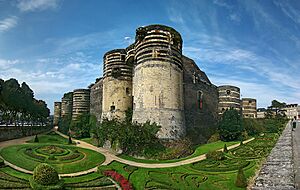
Angers got its first bishop in 372. The first abbey, Saint-Aubin, was built in the 600s. Another abbey, Saint-Serge, was founded a century later. In 2008, ten old Frankish coffins were found during tramway construction.
From the 850s, Angers was often in danger because it was near the borders of Brittany and Normandy. In 851, a peace treaty was signed in Angers. But the city remained unsafe.
In 870, the Viking leader Hastein took control of Angers. He stayed there until he was temporarily forced out. He took it again in 873 before the Emperor removed him.
Fulk I of Anjou became the first count of Angers around 929. He started the first Anjou ruling family. Angers then became the capital of the Anjou region.
In the 1100s, Henry II Plantagenêt ruled a huge empire. It stretched from the Pyrenees mountains to Ireland. The castle of Angers was the main home for his family. This empire ended in 1204-1205 when the King of France took over.
Angers became known as the "Key to the Kingdom" because it faced independent Brittany. In 1228, King Louis IX ordered the city and castle to be strengthened. Later, in the 1350s and 1360s, the city's schools of Law, Medicine, and Theology became a famous university. In 1373, Louis I ordered the creation of the Apocalypse Tapestry. This tapestry shows scenes from the Bible.

Angers in the Renaissance

King René of Anjou helped Angers recover after the Black Death and the Hundred Years War. René was a very cultured and generous man. He made Angers a center for culture and politics. He turned the castle moat into a zoo and built several gardens.
In 1474, King Louis XI of France took over Anjou. René, who was 65, did not want to fight his nephew. So, Anjou became part of the French kingdom. After René died in 1480, he was buried in Saint-Maurice cathedral.
In 1598, the Edict of Nantes was prepared in Angers by King Henri IV. This important document gave rights to Protestants in France. For a short time, Angers was like the capital of France.
Angers in Later Centuries
In 1619, King Louis XIII of France gave control of Anjou to his mother, Marie de' Medici. She lived in Angers.
In 1649, the people of Angers protested against high taxes. This was part of a larger conflict in France called the Fronde. The city was almost attacked by royal forces, but the Bishop of Angers helped prevent it.
Angers During the French Revolution
The start of the French Revolution was calm in Angers. In 1790, Angers lost its old administrative roles. It became part of the new "Maine-et-Loire" area. The Anjou region as a political area disappeared.
The War in the Vendée, a royalist uprising, reached the Loire river in 1793. The royalist army attacked Angers on December 3 and 4, 1793. The city was defended by 4,000 soldiers. The royalists had more people, but they were tired from other battles. Angers' strong city walls and castle helped the defenders win.
After the battle, many royalists were captured. Some died in jail. Angers also welcomed many people who had to leave their homes because of the fighting.
Angers Since 1800
In the 1800s, Angers changed a lot, similar to Paris. Many old parts of the city were rebuilt. The city wall was taken down around 1850. Wide boulevards replaced it. New areas were built on the other side of the river.
In 1849, a railway was built connecting Angers to Saumur. This line later connected Paris to the Atlantic coast.
In 1850, a terrible accident happened. The Angers Bridge collapsed, killing over 200 soldiers. This accident stopped the building of similar bridges in France for many years. The bridge broke because the soldiers' marching caused it to shake too much.
In 1875, a "free faculty" was created. It became the Catholic University of Angers. In 1971, a public university was also created. So, Angers now has two universities.
In the early 1900s, many beautiful buildings in the Art Nouveau and Art Deco styles were built. Examples include the Nouvelles Galeries and the Maison bleue.
In September 1939, when Germany invaded Poland, the Polish government moved to Angers. They left in June 1940 when France was invaded by the Nazis. Angers was then controlled by the Nazis. In 1941, a Resistance group was formed in Angers. In July 1942, many Jewish people were arrested and sent to Auschwitz.
On May 28, 1944, the Allies bombed Angers. Many people died, and buildings were destroyed. The train station was hit and rebuilt in the 1950s.
American forces, led by General Patton, reached Angers on August 5. They fought the Nazis and, with help from local French fighters, liberated Angers on August 10.
After the war, Angers grew quickly. New housing and shopping centers were built. A highway was built through the city center, which meant some old buildings were removed. Later, new plans focused on protecting nature and old buildings. The Saint-Serge area was redeveloped in the 1990s. It became a new business center with gardens and university buildings.
How Angers is Managed
Angers received its first official city rules in 1475. Free elections for the mayor started in 1484. Since then, 75 mayors have led Angers. The current mayor (as of May 2023) is Jean-Marc Verchère.
Angers is divided into eight areas called cantons. These are used for electing members to the local government council. Angers is also the main city of the Maine-et-Loire department. It has a Court of Appeal and other important regional offices.
Angers' Population and People
In 2017, Angers had 152,960 people. This was 1.2% more than ten years before. It is the 18th most populated city in France. The larger urban area, including Angers and nearby towns, had 242,613 people in 2018. The even wider metropolitan area had 432,939 people.
The people of Angers are quite young. About 46% of the population is under 30. This is partly because of the two universities in the city. About 21% of people aged 15 to 64 are students.
| Historical population | |||||||||||||||||||||||||||||||||||||||||||||||||||||||||||||||||||||||||||||||||||||||||||||||||||||||||||||||||||||||
|---|---|---|---|---|---|---|---|---|---|---|---|---|---|---|---|---|---|---|---|---|---|---|---|---|---|---|---|---|---|---|---|---|---|---|---|---|---|---|---|---|---|---|---|---|---|---|---|---|---|---|---|---|---|---|---|---|---|---|---|---|---|---|---|---|---|---|---|---|---|---|---|---|---|---|---|---|---|---|---|---|---|---|---|---|---|---|---|---|---|---|---|---|---|---|---|---|---|---|---|---|---|---|---|---|---|---|---|---|---|---|---|---|---|---|---|---|---|---|---|
|
|
|
|||||||||||||||||||||||||||||||||||||||||||||||||||||||||||||||||||||||||||||||||||||||||||||||||||||||||||||||||||||
| Source: Base Cassini from EHESS (1793-1999) and INSEE (1968-2017) | |||||||||||||||||||||||||||||||||||||||||||||||||||||||||||||||||||||||||||||||||||||||||||||||||||||||||||||||||||||||
Angers' Economy and Jobs
Angers became wealthy partly because of nearby slate quarries. Slate was used for many roofs, which is why it was called the "Black City." In the mid-1800s, Angers made things for sailing ships, like sailcloth and rope. It also produced linen, sugar, and agricultural products like wheat and wine.
By World War I, Cointreau had started making its famous orange liqueur from local fruit. Today, Angers provides 45.7% of the jobs in the Maine-et-Loire area. It is the 22nd largest job provider in France.
Modern Angers produces Scania trucks and computers. It also has research labs for horticulture and biotechnology. Angers is the biggest center for gardening in Europe. It is also home to the European office for new plant varieties. This makes Angers a key place for plant breeders' rights. For example, Angers is Europe's top producer of hydrangeas.
The local economy also relies on many government, education, and health organizations. There are also many small businesses, often linked to the area's farming traditions. Angers is also a regional financial center with many banks and insurance companies.
Angers is a big center for conventions and events. The Parc des Expositions hosts many fairs and events each year. It is the biggest building of its kind in northwestern France.
Getting Around Angers
Angers is located where three major highways meet. These highways connect it to Paris, Nantes, La Roche-sur-Yon, Tours, and Lyon.
Angers opened its new Irigo tram system on June 25, 2011. The tram has one line that is 12 km (7.5 mi) long with 25 stops. It runs from north to south, passing through the city center and the train station. The tram uses a special system that avoids overhead wires in the historic center. A second line is planned for the future. Besides the tram, Irigo also runs the bus network in Angers.
The main train station, Angers Saint-Laud, is on a TGV (high-speed train) line. You can take direct TGV trains to Paris (1 hour 30 minutes), Lyon, Strasbourg, and Lille. Regional trains go to nearby cities like Cholet and Saumur.
The closest airport is Angers - Loire Airport. It is about 20 km (12 mi) from Angers. It can handle 50,000 passengers each year.
Angers' Culture and Fun
Main Sights to See in Angers
The Angers Castle sits on a rocky hill overlooking the Maine river. The castle was built between 1230 and 1240 by King Louis IX of France. Its huge walls are about one kilometer (0.6 miles) long. They have 17 towers made of different colored stone, giving them a striped look. A chapel and a small castle building were added later.
The Maison d'Adam ("Adam's House") is behind the cathedral. It is a great example of the half-timbered houses from the Middle Ages. Many similar, smaller houses are also in the streets around the castle. The city also has beautiful Renaissance and classical mansions. The Maison bleue ("Blue House"), built in 1927, is an Art Deco masterpiece.
The Angers Cathedral is a major landmark. Its two spires reach 75 meters (246 ft) high. Building started in the 1100s. The cathedral mixes Romanesque and Gothic styles. Its unique "Angevin Gothic" style spread to other parts of France and Italy. The twin spires were built in 1518 and 1523. The nearby Palais du Tau, the old bishop's palace, is from the 1100s.
Another tall landmark is the Tour Saint-Aubin. It was completed in 1170. It was once the bell-tower of an abbey that was closed down. The Hôpital Saint-Jean, founded by Henry II of England, was used as the city hospital until 1870.
Museums to Explore
The Musée des Beaux-Arts d'Angers is in the Logis Barrault. It has paintings and sculptures from the 1300s to today. It is known for its 1700s paintings. The museum also has a section on Angers' history.
Inside the castle, you can see the Apocalypse Tapestry. This tapestry is over 140 meters (460 ft) long. It is the largest medieval tapestry in the world. It shows scenes from the Bible's Book of Revelation.
The Musée Jean-Lurçat et de la tapisserie contemporaine is in the old Hôpital Saint-Jean. It shows tapestries from the 1800s and 1900s. It is dedicated to Jean Lurçat, an artist who helped bring back modern tapestry. His work "Chant du Monde" is a modern response to the Apocalypse Tapestry.
The Muséum d'histoire naturelle d'Angers has a large collection of animals, fossils, and plants. The Logis Pincé museum has ancient Egyptian, Greek, Roman, and Etruscan items. It also has Chinese and Japanese artifacts.
The Galerie David d'Angers shows sculptures by David d'Angers, a famous 1800s sculptor from the city.
Entertainment and Shows
The Grand Théâtre is on the Place du Ralliement. It was rebuilt in 1871 after a fire. It has 730 seats. The Théâtre du Quai, opened in 2007, has two stages. These theaters host opera, dance, and plays.
The Orchestre National des Pays de la Loire often performs at the Congress Center. Other places for concerts include the Chabada and the Amphitéa. Each September, Angers hosts a street performance festival called Accroche-Cœurs.
Angers has a lively music scene. Many groups started at the Chabada concert hall. The city also hosts the Premiers Plans festival each year. This festival shows first films by European directors.
Media in Angers
Angers has a local TV channel called Angers Télé. National French TV also shows local news. Several national radio stations have local offices in Angers. There are also two local radio stations. The city has two local newspapers, Ouest-France and Le Courrier de l'Ouest.
Sports in Angers
Angers has many sports teams that play at high levels. Angers SCO is the city's football team. It was created in 1919 and returned to France's top league in 2015. Les Ducs d'Angers is the city's ice hockey team. They play in the top division. Anjou BC is Angers's basketball team, playing in the second division. Vaillante Angers is the city's table tennis team. They have been in the top division since 2000. Angers also has a rowing club that competes actively.
The Raymond Kopa Stadium is the main sports venue. It can hold 18,000 people. The city also has many sports halls, tennis courts, swimming pools, and an ice rink. The Lac de Maine Stadium hosted France's athletics championships in 2009.
Famous People from Angers
- Joan of England, Queen of Sicily (1165–1199), Queen of Sicily.
- René of Anjou (1409–1480), Duke of Anjou.
- Jean Bodin (1529–1596), philosopher.
- Joseph Proust (1754–1826), chemist.
- Michel Eugène Chevreul (1786–1889), chemist.
- David d'Angers (1788–1856), sculptor.
- Hervé Bazin (1911–1996), writer.
- Henri Dutilleux (1916–2013), composer.
- Jacques Loussier (1934–2019), jazz pianist.
- Nicolas Mahut (born 1982), tennis player.
- Sofiane Boufal (born 1993), football player.
- Adèle Castillon (born 2001), musician.
Angers' Sister Cities
Angers is connected with these cities around the world:
Images for kids
-
The Logis Barrault, where the Edict of Nantes was prepared
See also
 In Spanish: Angers para niños
In Spanish: Angers para niños






